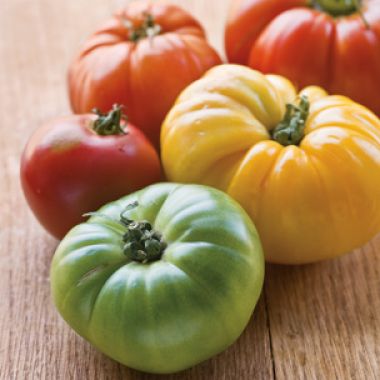All About Tomatoes

Once feared as poisonous, then considered a possible aphrodisiac, the "love apple" now adds its vivid color and delicious flesh to innumerable dishes. Like the potato, this fruit (which is generally treated as a vegetable) is a member of the nightshade family and is native to South America. After finally gaining acceptance as a food in Europe and the United States, tomatoes became an inextricable part of many cuisines.
Heirloom tomatoes are old-fashioned varieties that have been reintroduced by farmers and gardeners. These tomatoes are full of flavor, but they may not keep as long as more commonly available varieties.
Selecting
Although tomatoes are available year-round, they are best when eaten at the height of their natural season, usually June through September. For the best summer tomatoes, visit farm stands, farmers' markets and natural-food stores for vine-ripened tomatoes, or grow your own. Choose organic tomatoes, if possible, as they are likely to be more flavorful.
When fresh tomatoes are out of season, use canned (or packaged) imported plum tomatoes, usually called Italian tomatoes. They will have a much better flavor than will poor-quality fresh ones.
Storing
Store ripe tomatoes at room temperature for up to 3 days. If they are slightly unripe, put them in a sunny place for several days and they will ripen further. Although whole fresh tomatoes should not be refrigerated, cut tomatoes should be wrapped in plastic wrap or waxed paper and refrigerated.
Preparing
Wash and dry tomatoes to be sliced. Cut out the stem end and leave the tomatoes whole or cut them into crosswise or lengthwise slices or into wedges, or chop, according to the recipe. Pull off the stems of cherry tomatoes. Some recipes call for peeled and/or seeded tomatoes, usually when the tomatoes are to be chopped for a sauce.
Adapted from Williams-Sonoma Kitchen Companion: The A to Z Guide to Everyday Cooking, Equipment and Ingredients (Time-Life Books, 2000)
